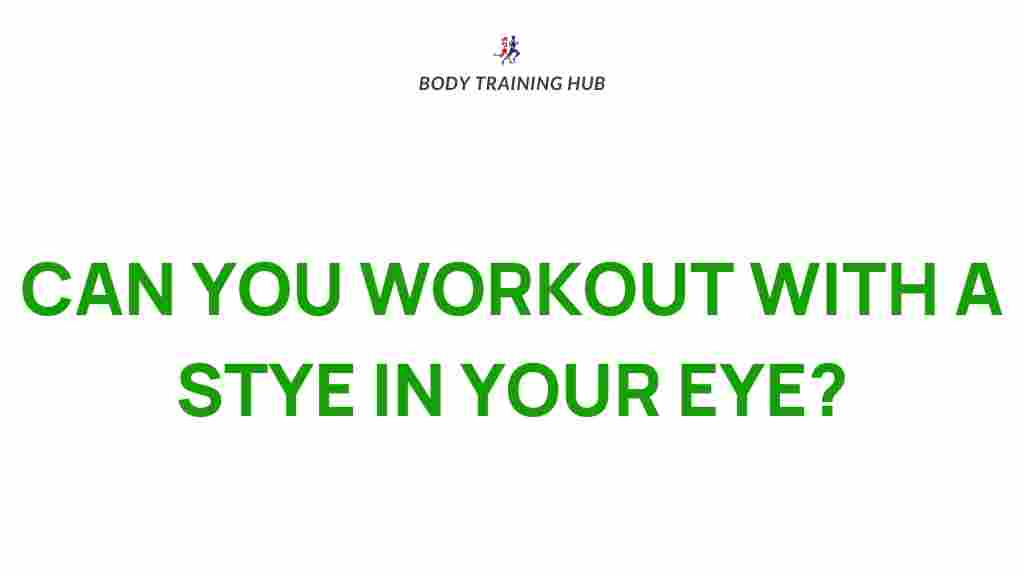How to Maintain Your Workout Routine with an Eye Stye
An eye stye can feel like a frustrating hurdle, especially if you’re committed to your fitness routine. Whether you’re a gym enthusiast or prefer outdoor activities, it’s essential to understand how to safely incorporate your workout schedule without worsening your condition. This guide offers expert insights and practical tips to help you navigate exercising with a stye effectively.
What is an Eye Stye?
A stye is a small, painful lump that forms near the edge of the eyelid, caused by a bacterial infection of an oil gland or hair follicle. While it may not pose serious health risks, it can cause discomfort and interfere with daily activities, including your workout.
Symptoms include:
- Redness and swelling on the eyelid
- Pain or tenderness around the eye
- Discharge or crustiness near the affected area
- Increased sensitivity to light
Though a stye typically resolves on its own within a week or so, exercising during this time requires extra caution to prevent complications.
Can You Exercise with an Eye Stye?
Yes, you can still maintain your workout routine with an eye stye, but it’s crucial to take certain precautions. Factors such as the intensity of the exercise, hygiene practices, and the stye’s severity play a significant role in determining whether it’s safe to work out.
Precautions to Take During a Workout
To protect your eye and ensure a safe exercise session, follow these precautionary steps:
1. Maintain Proper Hygiene
Eye styes can worsen with exposure to bacteria, so prioritize hygiene during your workout. Here’s how:
- Wash your hands thoroughly before touching gym equipment or your face.
- Avoid sharing towels, yoga mats, or other personal items.
- Use a clean, disposable wipe to dab sweat from your face.
2. Avoid High-Intensity Workouts
Strenuous exercises that cause excessive sweating can irritate your eye. Opt for low-impact activities such as:
- Walking or light jogging
- Gentle yoga or stretching
- Strength training with minimal exertion
3. Keep the Affected Area Dry
Sweat can aggravate a stye and increase irritation. Use a headband or sweatband to prevent sweat from dripping into your eyes during your workout.
4. Avoid Touching or Rubbing Your Eye
Rubbing the eye can spread bacteria and worsen the condition. If you experience itching or discomfort during your exercise, take a short break and use a sterile tissue or wipe for relief.
Step-by-Step Guide to Working Out Safely
Step 1: Assess the Severity of Your Stye
Before heading to the gym, evaluate the condition of your stye. If you experience severe pain, swelling, or pus, consider postponing your workout and consulting a healthcare professional.
Step 2: Prepare Your Fitness Space
Whether at home or the gym, ensure your exercise environment is clean. Disinfect equipment and lay down a clean mat to minimize bacterial exposure.
Step 3: Choose the Right Attire
Wear breathable, moisture-wicking clothing and keep a clean towel nearby. If possible, use a visor or hat to shield your eyes from sweat.
Step 4: Follow a Gentle Workout Plan
Focus on exercises that don’t require heavy lifting or intense movement. Examples include:
- Stationary cycling at a slow pace
- Pilates routines
- Resistance band exercises
Step 5: Cool Down and Clean Up
After your workout, gently wash your face with lukewarm water and a mild cleanser. Avoid scrubbing the affected eye area.
Troubleshooting Common Issues
Even with precautions, challenges can arise during your workout. Here’s how to handle them:
Excessive Sweating
If sweat becomes a problem, pause your exercise and pat your face dry with a clean towel. Avoid applying pressure near the stye.
Increased Irritation
Should irritation worsen during your session, it’s best to stop and apply a warm compress to the affected eye. This can soothe discomfort and reduce swelling.
Longer Recovery Time
If your stye isn’t healing as expected, consider reducing your workout frequency or intensity. Consult a healthcare provider for advice on proper care.
When to Seek Medical Attention
Though most styes resolve without intervention, certain symptoms may require professional care:
- Severe pain or swelling
- Vision changes
- Persistent symptoms beyond two weeks
- Multiple styes or recurring infections
In such cases, consult an eye specialist for guidance. You can find more detailed health advice on Healthline.
Maintaining Fitness During Recovery
Staying active while dealing with a stye is possible with the right precautions. Adjusting your workout routine ensures you remain on track with your fitness goals while protecting your eye health. For more fitness tips and routines, check out our fitness blog.
Conclusion
Exercising with an eye stye doesn’t have to derail your fitness journey. By following hygiene practices, choosing low-impact exercises, and addressing issues promptly, you can safely continue your workout routine while allowing your eye to heal. Remember, listening to your body is key—if something feels off, don’t hesitate to pause and seek professional help.
Stay fit, stay healthy, and take care of your eyes!
This article is in the category Myths & Facts and created by BodyTraining Team
